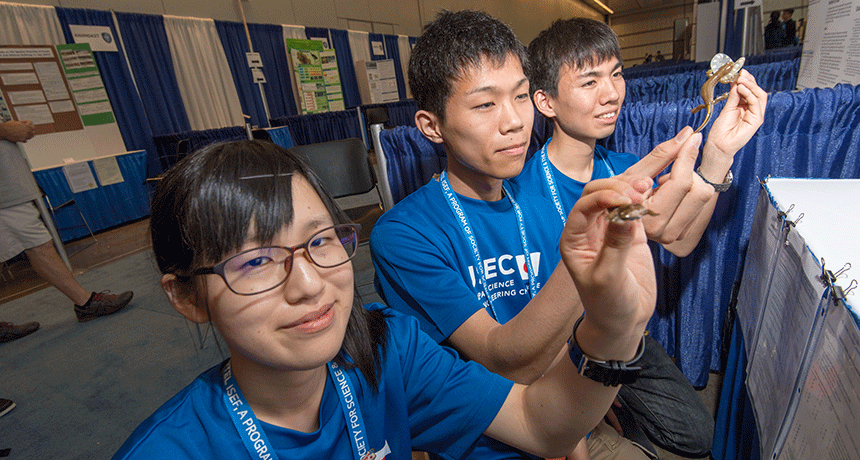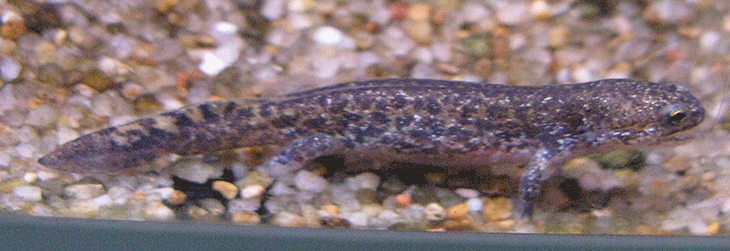Hunting hidden salamanders with eDNA
Three teens use genetic techniques to pinpoint a new population of these very rare animals

From left: Yuka Tsuzuku,Yusuke Sakai, and Kota Tsuchida pose at Intel ISEF with model salamanders and model salamander eggs.
C. AYERS PHOTOGRAPHY/SOCIETY FOR SCIENCE & THE PUBLIC
PITTSBURGH, Pa. — Salamanders are small, often camouflaged amphibians. How do you find them hiding in their environment? Three teens used a combination of geographic sleuthing, bits of shed DNA and their own eyeballs. And their approach paid off. They found a new population of an especially rare species of these animals.
As their name suggests, Japanese clouded salamanders are native to Japan. But they are not commonly found throughout the country. Indeed, notes Yuka Tsuzuku, 17, in her prefecture of Gifu, “There were only three [known] habitats in 2016.” Like Yosuke Sakai, 17, and Kota Tsuchida, 18, she was worried about these animals.
All three teens are seniors at Gifu Senior High School in Gifu City, Japan. And they knew why the species had been struggling. These salamanders need wet conditions — like the rice paddies found around Gifu Prefecture — to breed. However, Yuka notes, “Paved roads prevent the adult salamander from going to their spawning grounds.” The students noticed new apartment complexes and roads were replacing wet rice paddies with dry asphalt. This made it hard for the salamanders to reach their habitat.
(Story continues below image)

“Gifu is the northern edge of the salamander’s habitat,” Yuka explains. If the animals couldn’t survive in this province, the teens worried that their region of Japan could soon become salamander-free.
Their high school’s biology club has dedicated itself to saving the local clouded salamanders. To do their part, these three students decided to scout for unknown populations of the animals in Gifu. But hunting salamanders is a tough task. “Manual field surveys, such as going to the mountains, [are] very hard,” Kota notes. It takes a very long time, he says. Indeed, Gifu Prefecture is so large, he observes, that such a field survey “might take 30 years.”
Kota, Yusuke and Yuka did not have 30 years. They needed something faster. They started with a geographic information system, or GIS. This is a computer program that can store a mountain of data about some region’s geography. Without the computer, so much data would have been hard to sort quickly. But with it, the teens now could narrow down their search by focusing on sites with environmental features that the salamanders needed.
They started their search with 6,000 potential sites. The teens then narrowed these down to just five sites with prime salamander habitat.
The teens then headed out to each one. At each site they collected samples of water and soil. They shared these with Minamoto Toshifumi.
Toshihumi is an environmental scientist at Kobe University, several hours away. He graduated from the teens’ high school. But more importantly, he studies genetic material known as environmental DNA, or eDNA. DNA contains the instructions for living things. It’s normally found inside cells. But organisms shed some cells — and their DNA — all the time. Some of that eDNA will end up littering any environment in which an organism had lived. So a savvy scientist (or three) can take a sample from the environment, and hunt through the many types of eDNA in it, searching for genetic evidence of a target species.
Toshihumi helped Yuka, Yusuke and Kota extract DNA from the water and soil. The teens were in luck. Two of their samples had clouded salamander eDNA. That means one or more of these amphibians might be nearby. The teens headed back to the site and began searching. Soon, they found a few clear, slimy, transparent packets.
Jackpot! These were clouded salamander eggs — and proof that animals were living nearby.
Thrilled, Yusuke notes that “we found a new population of clouded salamander in a year.” They handed off the eggs to a local zookeeper. “The young salamander is very sensitive,” Yusuke says. The zookeeper raised the hatchlings and released the animals back into the wild once they became adults.
The three teens described their newly discovered salamander population here, earlier this month, at the Intel International Science and Engineering Fair (ISEF). This year, the fair brought together nearly 1,800 students from 81 countries to share their science fair projects. The competition was created and is run by Society for Science & the Public. The fair is sponsored by Intel this year. (The Society also publishes Science News for Students and this blog.) For their salamander project, the trio took home a second place award of $1,500 in the Animal Sciences category.
Yusuke, Yuka and Kota still have two other promising sites in which to hunt for salamanders. In the meantime, they have contacted their local government, asking them to preserve the newly discovered salamander habitat.
While these teens think the salamanders are cute, Yuka says they have another reason to protect these tiny amphibians. “Our ancestors lived in harmony with nature,” she says. “The Japanese clouded salamander lives in that habitat and conserving the salamander will conserve the traditional habitat.”
Editor’s Note: This article was updated at 10:15AM on 6/4/18 to correct the order in which the names of the teens appear in the top photograph, to clarify the source of the quote in paragraph two and to correct the spelling of Toshifumi’s name.







